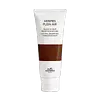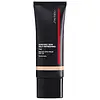What's inside
What's inside
 Key Ingredients
Key Ingredients

 Benefits
Benefits

 Concerns
Concerns

 Ingredients Side-by-side
Ingredients Side-by-side

Water
Skin ConditioningMethyl Trimethicone
Skin ConditioningNeopentyl Glycol Diethylhexanoate
EmollientMica
Cosmetic ColorantDimethicone
EmollientDipropylene Glycol
HumectantPEG-10 Dimethicone
Skin ConditioningCyclopentasiloxane
EmollientVinyl Dimethicone/Methicone Silsesquioxane Crosspolymer
Pentylene Glycol
Skin ConditioningButylene Glycol
HumectantGlycerin
HumectantPhenoxyethanol
PreservativeSorbitol
HumectantPolyglyceryl-2 Diisostearate
EmulsifyingSodium Citrate
BufferingTrimethylsiloxysilicate
EmollientDisteardimonium Hectorite
StabilisingSodium Chloride
MaskingParfum
MaskingCaprylic/Capric Triglyceride
MaskingTocopherol
AntioxidantDimethicone/Vinyl Dimethicone Crosspolymer
Skin ConditioningGlycine
BufferingBenzyl Salicylate
PerfumingSodium Hyaluronate
HumectantScutellaria Baicalensis Root Extract
AstringentLimonene
PerfumingOenothera Biennis Seed Extract
Skin ConditioningMorus Alba Bark Extract
Skin ConditioningGeraniol
PerfumingCitronellol
PerfumingLinalool
PerfumingHydroxycitronellal
PerfumingCI 77891
Cosmetic ColorantCI 77491
Cosmetic ColorantWater, Methyl Trimethicone, Neopentyl Glycol Diethylhexanoate, Mica, Dimethicone, Dipropylene Glycol, PEG-10 Dimethicone, Cyclopentasiloxane, Vinyl Dimethicone/Methicone Silsesquioxane Crosspolymer, Pentylene Glycol, Butylene Glycol, Glycerin, Phenoxyethanol, Sorbitol, Polyglyceryl-2 Diisostearate, Sodium Citrate, Trimethylsiloxysilicate, Disteardimonium Hectorite, Sodium Chloride, Parfum, Caprylic/Capric Triglyceride, Tocopherol, Dimethicone/Vinyl Dimethicone Crosspolymer, Glycine, Benzyl Salicylate, Sodium Hyaluronate, Scutellaria Baicalensis Root Extract, Limonene, Oenothera Biennis Seed Extract, Morus Alba Bark Extract, Geraniol, Citronellol, Linalool, Hydroxycitronellal, CI 77891, CI 77491
Ethylhexyl Methoxycinnamate 6.7%
UV AbsorberOctocrylene 3%
UV AbsorberTitanium Dioxide 2%
Cosmetic ColorantWater
Skin ConditioningDimethicone
EmollientGlycerin
HumectantTrifluoropropyldimethyl/Trimethylsiloxysilicate
EmollientCaprylyl Methicone
Skin ConditioningButylene Glycol
HumectantDimethicone/PEG-10/15 Crosspolymer
Sodium Chloride
MaskingSynthetic Fluorphlogopite
Squalane
EmollientHydrogenated Polyisobutene
EmollientThymus Serpyllum Extract
Skin ConditioningDimethicone/Vinyl Dimethicone Crosspolymer
Skin ConditioningPolyquaternium-51
Skin ConditioningSodium Hyaluronate
HumectantHydrolyzed Conchiolin Protein
Skin ConditioningSorbitan Sesquiisostearate
EmulsifyingDisteardimonium Hectorite
StabilisingPEG-10 Dimethicone
Skin ConditioningAluminum Hydroxide
EmollientStearic Acid
CleansingTrisodium EDTA
Hydroxyethyl Acrylate/Sodium Acryloyldimethyl Taurate Copolymer
Emulsion StabilisingLithium Magnesium Sodium Silicate
AbsorbentPolysilicone-2
Sodium Citrate
BufferingDipropylene Glycol
HumectantPolysorbate 60
EmulsifyingIsododecane
EmollientPEG/PPG-19/19 Dimethicone
EmulsifyingBHT
AntioxidantTocopherol
AntioxidantSorbitan Isostearate
EmulsifyingTrimethylsiloxysilylcarbamoyl Pullulan
Polymethylsilsesquioxane
Phenoxyethanol
PreservativeIron Oxides
Mica
Cosmetic ColorantEthylhexyl Methoxycinnamate 6.7%, Octocrylene 3%, Titanium Dioxide 2%, Water, Dimethicone, Glycerin, Trifluoropropyldimethyl/Trimethylsiloxysilicate, Caprylyl Methicone, Butylene Glycol, Dimethicone/PEG-10/15 Crosspolymer, Sodium Chloride, Synthetic Fluorphlogopite, Squalane, Hydrogenated Polyisobutene, Thymus Serpyllum Extract, Dimethicone/Vinyl Dimethicone Crosspolymer, Polyquaternium-51, Sodium Hyaluronate, Hydrolyzed Conchiolin Protein, Sorbitan Sesquiisostearate, Disteardimonium Hectorite, PEG-10 Dimethicone, Aluminum Hydroxide, Stearic Acid, Trisodium EDTA, Hydroxyethyl Acrylate/Sodium Acryloyldimethyl Taurate Copolymer, Lithium Magnesium Sodium Silicate, Polysilicone-2, Sodium Citrate, Dipropylene Glycol, Polysorbate 60, Isododecane, PEG/PPG-19/19 Dimethicone, BHT, Tocopherol, Sorbitan Isostearate, Trimethylsiloxysilylcarbamoyl Pullulan, Polymethylsilsesquioxane, Phenoxyethanol, Iron Oxides, Mica
 Reviews
Reviews

Ingredients Explained
These ingredients are found in both products.
Ingredients higher up in an ingredient list are typically present in a larger amount.
Butylene Glycol (or BG) is used within cosmetic products for a few different reasons:
Overall, Butylene Glycol is a safe and well-rounded ingredient that works well with other ingredients.
Though this ingredient works well with most skin types, some people with sensitive skin may experience a reaction such as allergic rashes, closed comedones, or itchiness.
Learn more about Butylene GlycolDimethicone is a type of synthetic silicone created from natural materials such as quartz.
What it does:
Dimethicone comes in different viscosities:
Depending on the viscosity, dimethicone has different properties.
Ingredients lists don't always show which type is used, so we recommend reaching out to the brand if you have questions about the viscosity.
This ingredient is unlikely to cause irritation because it does not get absorbed into skin. However, people with silicone allergies should be careful about using this ingredient.
Note: Dimethicone may contribute to pilling. This is because it is not oil or water soluble, so pilling may occur when layered with products. When mixed with heavy oils in a formula, the outcome is also quite greasy.
Learn more about DimethiconeThis ingredient is a silicone used to improve the texture of products and absorb oil. It does not get absorbed into the skin.
Like other silicones, Dimethicone/Vinyl Dimethicone Crosspolymer helps condition the skin by creating a barrier. In this sense, it can act as an emollient and trap moisture in.
This ingredient is a type of elastomer.
Learn more about Dimethicone/Vinyl Dimethicone CrosspolymerDipropylene Glycol is a synthetically created humectant, stabilizer, and solvent.
This ingredient helps:
Dipropylene glycol is technically an alcohol, but it belongs to the glycol family (often considered part of the ‘good’ alcohols). This means it is hydrating and gentle on skin unlike drying solvent alcohols like denatured alcohol.
As a masking agent, Dipropylene Glycol can be used to cover the smell of other ingredients. However, it does not have a scent.
Studies show Dipropylene Glycol is considered safe to use in skincare.
Learn more about Dipropylene GlycolDisteardimonium Hectorite comes from the clay mineral named hectorite. It is used to add thickness to a product.
It can also help stabilize a product by helping to disperse other ingredients.
Hectorite is a rare, white clay mineral.
Learn more about Disteardimonium HectoriteGlycerin is already naturally found in your skin. It helps moisturize and protect your skin.
A study from 2016 found glycerin to be more effective as a humectant than AHAs and hyaluronic acid.
As a humectant, it helps the skin stay hydrated by pulling moisture to your skin. The low molecular weight of glycerin allows it to pull moisture into the deeper layers of your skin.
Hydrated skin improves your skin barrier; Your skin barrier helps protect against irritants and bacteria.
Glycerin has also been found to have antimicrobial and antiviral properties. Due to these properties, glycerin is often used in wound and burn treatments.
In cosmetics, glycerin is usually derived from plants such as soybean or palm. However, it can also be sourced from animals, such as tallow or animal fat.
This ingredient is organic, colorless, odorless, and non-toxic.
Glycerin is the name for this ingredient in American English. British English uses Glycerol/Glycerine.
Learn more about GlycerinMica is a naturally occurring mineral used to add shimmer and color in cosmetics. It can also help improve the texture of a product or give it an opaque, white/silver color.
Serecite is the name for very fine but ragged grains of mica.
This ingredient is often coated with metal oxides like titanium dioxide. Trace amounts of heavy metals may be found in mica, but these metals are not harmful in our personal products.
Mica has been used since prehistoric times throughout the world. Ancient Egyptian, Indian, Greek, Roman, Aztec, and Chinese civilizations have used mica.
Learn more about MicaPeg-10 Dimethicone is silicone with conditioner and emulsifier properties. It mostly acts as an emollient in skincare and and humectant in haircare.
According to the manufacturer, acidic formulations decrease the stability of this ingredient. It works best in neutral or near neutral formulations.
Phenoxyethanol is a preservative that has germicide, antimicrobial, and aromatic properties. Studies show that phenoxyethanol can prevent microbial growth. By itself, it has a scent that is similar to that of a rose.
It's often used in formulations along with Caprylyl Glycol to preserve the shelf life of products.
Chances are, you eat sodium chloride every day. Sodium Chloride is also known as table salt.
This ingredient has many purposes in skincare: thickener, emulsifier, and exfoliator.
You'll most likely find this ingredient in cleansers where it is used to create a gel-like texture. As an emulsifier, it also prevents ingredients from separating.
There is much debate on whether this ingredient is comedogenic. The short answer - comedogenic ratings don't tell the whole story. Learn more about comegodenic ratings here.
The concensus about this ingredient causing acne seems to be divided. Research is needed to understand if this ingredient does cause acne.
Scrubs may use salt as the primary exfoliating ingredient.
Learn more about Sodium ChlorideSodium Citrate is the sodium salts of citric acid. In skincare, it is used to alter pH levels and acts as a preservative.
Its main functions are to maintain the pH of a product and neutralize metal ions.
The acidity of our skin is maintained by our glands and skin biome; normal pH level of skin is slightly acidic (~4.75-5.5).
Being slightly acidic allows our skin to create an "acid mantle". This acid mantle is a thin barrier that protects our skin from bacteria and contaminants.
Learn more about Sodium CitrateSodium Hyaluronate is hyaluronic acid's salt form. It is commonly derived from the sodium salt of hyaluronic acid.
Like hyaluronic acid, it is great at holding water and acts as a humectant. This makes it a great skin hydrating ingredient.
Sodium Hyaluronate is naturally occurring in our bodies and is mostly found in eye fluid and joints.
These are some other common types of Hyaluronic Acid:
Learn more about Sodium HyaluronateTocopherol (also known as Vitamin E) is a common antioxidant used to help protect the skin from free-radicals and strengthen the skin barrier. It's also fat soluble - this means our skin is great at absorbing it.
Vitamin E also helps keep your natural skin lipids healthy. Your lipid skin barrier naturally consists of lipids, ceramides, and fatty acids. Vitamin E offers extra protection for your skin’s lipid barrier, keeping your skin healthy and nourished.
Another benefit is a bit of UV protection. Vitamin E helps reduce the damage caused by UVB rays. (It should not replace your sunscreen). Combining it with Vitamin C can decrease sunburned cells and hyperpigmentation after UV exposure.
You might have noticed Vitamin E + C often paired together. This is because it is great at stabilizing Vitamin C. Using the two together helps increase the effectiveness of both ingredients.
There are often claims that Vitamin E can reduce/prevent scarring, but these claims haven't been confirmed by scientific research.
Learn more about TocopherolWater. It's the most common cosmetic ingredient of all. You'll usually see it at the top of ingredient lists, meaning that it makes up the largest part of the product.
So why is it so popular? Water most often acts as a solvent - this means that it helps dissolve other ingredients into the formulation.
You'll also recognize water as that liquid we all need to stay alive. If you see this, drink a glass of water. Stay hydrated!
Learn more about Water